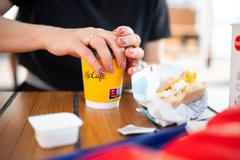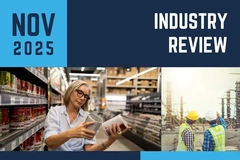
- Industry news
Industry news
- Category news
- Reports
- Key trends
- Multimedia
Multimedia
- Journal
- Events
- Suppliers
Suppliers
- Home
- Industry news
Industry news
- Category news
- Reports
- Key trends
- Multimedia
Multimedia
- Events
- Suppliers
Suppliers
Pack Expo 2024: Industry prepares to showcase new designs amid critical policy turning points

Next week Pack Expo 2024 will open its doors in Chicago, US, to over 45,000 attendees who will have the chance to visit over 2,600 packaging industry exhibitors. Industry leaders are preparing to showcase new designs and innovations for almost all sector applications. They will also lobby for legislative reforms in the lead-up to the UN Global Plastic Treaty and US national elections.
The show, held from 3-6 November, will spotlight a large number of new and powerful industry stakeholders. According to official show statistics, 35% of attendees will be CEOs or senior management officials, and 42% of attendees will be first time visitors. Thirty percent of companies attending have an annual revenue of over US$1 billion.
Special themes this year include the future of pharmaceutical manufacturing, achieving success in the craft spirits sector through packaging, cannabis packaging and the future under legislative reform.
Packaging Insights will be reporting live from the show floor. We speak to representatives from Greiner Packaging, Tipa and ProAmpac ahead of the show to get a preview on the products and technologies they will be displaying and the issues they will be discussing.
Entering a new policy climate
Pack Expo will run over the US national election, in which voters will choose between the climate and industry agendas put forward by the Democrat and Republican parties. A key development in the run up to the election was the announcement that the Democrats will likely back global caps on plastic production — something met with fierce resistance by American manufacturers.
This pledge was made in advance of final UN Global Plastic Treaty negotiations, which will be held at the end of November, in which nations will vote on how to reduce plastic pollution. Consensus is currently split between allowing individual states to determine their own methods, and enforcing global targets.
 The show floor will cover over 1.3 million sq. ft. in McCormick Place.The former would allow mass production to largely continue, with an emphasis on recycling. The latter would force a decrease in production, an idea the American Chemistry Council brands “a betrayal.”
The show floor will cover over 1.3 million sq. ft. in McCormick Place.The former would allow mass production to largely continue, with an emphasis on recycling. The latter would force a decrease in production, an idea the American Chemistry Council brands “a betrayal.”
Daphna Nissenbaum, CEO and co-founder of Tipa Compostable Packaging, tells us this shifting political period is a good opportunity for policymakers to adopt compostable technologies.
“The US election and progress on the UN Global Plastic Treaty could significantly affect the US market, depending on the outcomes. A supportive policy landscape would encourage businesses to adopt alternatives like Tipa’s packaging at greater scale, as well as encourage more composting infrastructure as part of standard waste management systems,” she says.
“Stricter regulations on single-use plastics and increased focus on circularity could drive further demand for compostable solutions. We’re excited about the potential for compostables to reshape the future of packaging and reduce plastic waste. With our expanded presence in North America and growing portfolio, Tipa is committed to delivering practical, high-performance solutions that align with consumer values and environmental goals.”
Preparing for 2025
Peter Dobosz, Greiner’s global expert for public relations and content marketing, says the US packaging market “is poised for significant transformation, largely driven by evolving governmental policies and increasing consumer expectations.”
He says the most important issues packagers need to be conscious of ahead of next year are:
Extended Producer Responsibility (EPR): “By 2025, companies will need to adapt to EPR responsibilities, which may include funding the recycling and disposal of their packaging. This shift necessitates a proactive strategy for managing packaging waste and aligning with evolving regulatory requirements.”
Shifting material usage and recycling practices: “With increasing scrutiny on non-recyclable and single-use plastics, companies are encouraged to transition toward recyclable, compostable or reusable materials. Embracing this shift not only helps ensure regulatory compliance but also fosters consumer loyalty.”
Circular economy developments: “Consumers are increasingly favoring brands that prioritize sustainable packaging solutions. By adopting eco-friendly materials and practices, businesses can align with regulatory shifts and meet market demand, enhancing brand value.”
Tracking and transparency requirements: “New policies may necessitate companies to disclose the environmental impacts of their packaging, including carbon footprints and recyclability rates. Establishing systems for accurate reporting will be crucial for compliance and fostering consumer trust.”
Numerous talks will be held at the show, including “Beyond EPR: Packaging Policy’s Expansion in the US,” and “Sustainability Regulations and the Impact to Supply Chain.”
Innovation showcasing
 The show will host numerous talks and panel discussions on industry issues.Kristy Paulin, executive vice president for ProAmpac, highlights that the company will be displaying its full range of products for different sectors.
The show will host numerous talks and panel discussions on industry issues.Kristy Paulin, executive vice president for ProAmpac, highlights that the company will be displaying its full range of products for different sectors.
“We’ll showcase our latest advancements in sustainable packaging across F&B, lawn and garden, and other key markets. From high-performance recyclable films to fiber-based innovations and smart packaging technology, we’re excited to present solutions that are shaping the future of packaging. Visit us to see firsthand how we’re leading the charge in pet food, grocery, e-commerce and beyond,” she says.
Meanwhile, Dobosz says that Greiner will be displaying its air up bottle, which uses scent-based technology to flavor water through the sense of smell, without additives or sugars.
“This innovative approach not only promotes healthier drinking habits but also supports sustainability by reducing the need for single-use flavored beverages,” he says. “The reusable design also helps to cut down on plastic waste, aligning with Greiner’s commitment to eco-friendly packaging.”
Nissenbaum says Tipa will unveil a range of new compostable packaging formats at the show. “This now includes compostable, paper-based laminations — further advancing our mission to reduce reliance on conventional flexible plastics, and giving brands more options for packaging their products. This addition illustrates how we combine sustainability with high-performance solutions that meet the needs of both brands and consumers.”
Facing challenges
Besides showcasing new products and innovations, the companies say the show is an opportunity to connect and prepare for market challenges ahead of next year.
“An ongoing challenge is navigating the sustainability transformation in an evolving regulatory landscape while maintaining our focus on delivering innovative and sustainable packaging solutions,” says Dobosz.
“As a company dedicated to sustainability, we aim to not only meet, but exceed regulatory requirements based on CO2 life cycle improvements. To navigate the sustainability transformation, we’re monitoring upcoming regulations to ensure timely adjustments while investing in R&D for innovative sustainable materials and conducting life cycle assessments to enhance compliance and performance.”
Nissenbaum says that compostables are emerging as a more popular solution to address the plastic crisis, and that the company is now enhancing its reach in North America with expanded local production through manufacturing partnerships.
“The compostables market in the US faces challenges around infrastructure, consumer education and regulatory consistency. While consumer awareness of plastic alternatives is growing, gaps in access to composting facilities and collection programs need to close in order to have more widespread adoption. Regulatory frameworks also need to catch up to recognize compostables and composting as a critical component of waste management,” she remarks.
“In 2025, we plan to build on our North American presence by expanding partnerships with brands, retailers and packaging producers. We aim to strengthen our product offerings to meet evolving market demands and enhance our impact on sustainability initiatives, both through regional production and tailored packaging solutions for key markets.”










